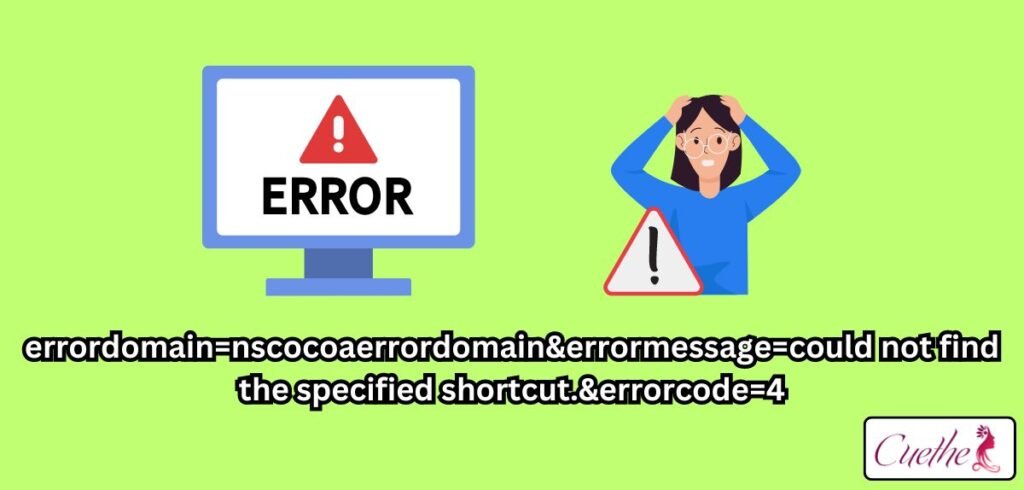As you know, Nowadays, more and more people use computers for work. The increasing availability of online work has led to a rise in the use of laptops. Furthermore, rather than making things more difficult, using modern technology makes the process of making these road keys easier. These road keys can be used for a variety of quick tasks, like using programs and opening files. But there are disadvantages to using shortcut keys as well as benefits. The major problem that you can run into is ErrorDomain=NSCocoaErrorDomain&ErrorMessage=Could Not Find the Specified Shortcut.&ErrorCode=4″ The Mac and iOS operating systems are most impacted by this particular problem.
About This Error
First, let’s define the Ns Cocoa Error Domain. For the purposes of this argument, let’s say that you work for a department office. Similar to this, a large computer system is made up of numerous departments that collaborate to complete various tasks. That’s why it was impossible to find the given shortcut (ErrorDomain=NSCocoaErrorDomain&ErrorMessage=Could Not Find the Specified Shortcut.&ErrorCode=4). Apple’s macOS and iOS operating systems have a division called &errorcode=4. It covers a wide range of topics that are generally related to issues with iOS and MacOS software.
Reason of the error occurred
There might be a number of reasons for this kind of error. Given below are the few reason of the error are:-
- Changes to the Shortcut Path: The system will not locate the shortcut if the path or location is relocated, removed, or altered. An error will result from this.
- Problems with Applications: Incompatible apps or older versions may conflict when upgrading to macOS. Shortcut problems could result from this clash.
- corrupted Preferences: Should there be corruption in the preferences, the problem may manifest itself. Either the shortcut or the program may be connected to this corruption.
- Installation mistakes: The system might not be able to locate the shortcut if a program is installed incorrectly or if certain files are missing. This might cause the product to install incompletely.
- System updates: From time to time, MacOS updates can lead to compatibility problems or malfunctions with shortcut functionality.
An issue’s cause has to be found in order to be appropriately fixed.
Process To Fix
If you find yourself in a similar situation in the future, you should take the following actions to resolve the issue. Simply follow the steps listed below to fix the problem:
- Check with the shortcut to make sure everything is operating as it should.
- See if there are any possible shortcuts.
- Examine the code. Look for any instances where there are coding mistakes.
- Verify that the shortcut continues to function on the most recent iteration of iOS. because not all shortcuts are supported by earlier iterations of MacOS and iOS.
- Provide an environment where mistakes can be examined and fixed.
- Get in touch with knowledgeable engineers for assistance in fixing the Ns Cocoa Error Domain problem.
Various Methods of Troubleshooting
To remove the error “ErrorDomain=nsCocoaErrorDomain&ErrorMessage=Could Not Find the Specified Shortcut.&ErrorCode=4” you need to follow the given below step:
Method-1: Check The Shortcut Path
- Launch the program or function that is connected to the shortcut.
- Check the settings or configurations for the shortcuts in the program.
- Check to make sure the route or location designated for the shortcut is correct and still exists.
- If a route is incomplete or erroneous, update it to the correct location.
Method-2: Restart The Application
- Delete the program that is linked to the issue.
- Download the latest software version from the official website to the device.
- It is necessary to follow the provided installation steps in order to install the application.
- Please restart the program if the problem persists.
Method-3: Update MacOS And Applications
- Navigate there to open the Mac App Store.
- Select “Updates” from the tab menu.
- Run any available macOS updates.
- Update all of the programs involved in the issue.
- To check if it fixes the issue, try restarting your computer.
Method-4: Reset MacOS Preferences
- Select the “Apple” menu in order to view the System Preferences screen.
- For the impacted program, select the preferences window.
- Discover the “Reset” or “Restore Defaults” button.
- Click on it to make the changes go back to how they were.
- See if the problem persists by trying to restart the program.
Prevention from Error Domain
To make sure that you don’t run into any issues, you need to complete these steps:
- Update macOS often: Make sure your macOS and apps remain compatible by keeping them up to current. Additionally, take this action to resolve any issues that have been identified.
- Make a System Backup: Provide a backup in case of errors or data loss. Make regular backups of the system or application settings.
- Verify Shortcut Paths: Ensure that the path or destination is correct. When utilizing key combinations or shortcuts, check it frequently.
- Observe Application Instructions: To avoid conflicts, follow any advice from the app’s creator.
Errors in shortcut usage can be minimized. Adhere to these safety precautions to do this.
Conclusion
In summary, debuggers and logs should be used by developers who are still unable to replicate or identify the cause of “Errordomain=nscocoaerrordomain&errormessage=could not find the specified shortcut.&errorcode=4” difficulties. Using debugging tools like asXCode, you can track a program’s execution line by line while keeping an eye on the system’s condition and the values of its variables. Breakpoints also make it possible to halt execution when a particular line of code is reached.
Disclaimer
All the details present in this article is only for the information purpose. The website does not guarantee any accuracy of the data.

